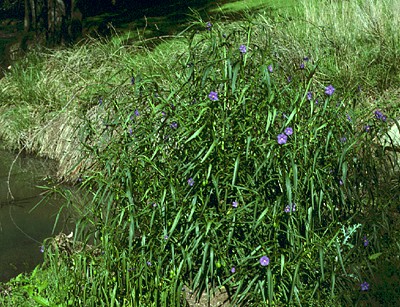
Synonymy
Solanum vescum F. Muell., Trans. & Proc. Victorian Inst. Advancem. Sci. 1: 69 (1855), & Hooker's J. Bot. Kew Gard. Misc. 7: 237 (1855). Note that Seberg, Taxon 35: 270 (1986) indicated the first place of publication to be in Mueller's 53 page Definitions of rare or hitherto undescribed Australian plants. (Goodhugh & Trembath, Melbourne), also dated 1855, but this seems unlikely since it is reprinted from the above.
S. aviculare var. vescum (F. Muell.) Ewart, Victorian Naturalist 24: 59 (1907).
T: [“Solanum vescum (S. decurrens) Guniang Natives Sandy places near the entrance of the
S. vescum var. davidii Geras. Rastitel'nost Resursy (Akademiya nauk SSSR)
S. vescum var. kibalczeczii Geras. Rastitel'nost Resursy (Akademiya nauk SSSR)
Description
Erect or spreading shrub to 2 m, green, glabrous except for minute, simple and glandular hairs on corolla, calyx apices, seedlings and young shoots; prickles absent.
Lobed leaves broadly ovate; lamina 10-50 cm long, concolorous, deeply lobed; lobes mostly 5-10 cm long, 8-12 mm wide, sometimes smaller; petiole to 3 cm long. Entire leaves linear-lanceolate, the lamina 5-15 cm long, 5-13 mm wide, sometimes larger, concolorous; petiole short or absent, often decurrent as narrow wing.
Inflorescence many-flowered; peduncle absent or up to 7 cm long; rachis 1-5 cm long; pedicels 2-3 cm long, becoming longer in fruit. Calyx 3-5 mm long; lobes triangular, 2-3 mm long. Corolla rotate-stellate, 35-40 mm diam., sometimes smaller, violet. Anthers 3-4 mm long. Fruiting axis to 15 cm long, the pedicels 2.5-5 cm long.
Berry globular or slightly ovoid, 20-25 mm diam., greenish-ivory. Seeds 2-3 mm long, greyish-brown. Stone-cell granules 1-2(3) mm long. n=23.
A full description of this species can also be found on A.R.Bean's treatment of the eastern Australian species of Solanum at http://delta-intkey.com/solanum/www/vescum.htm
Distribution and ecology
An Australian endemic, S. vescum is one of the Kangaroo Apples or subg. Archaeosolanum. It occurs in south-eastern Qld, eastern N.S.W., eastern Vic. and Tas., usually in coastal and near-coastal areas, on consolidated coastal dunes, stream banks, and margins of forest and woodland.
Common name
[Green] Kangaroo Apple, gunyang
Relationships
One of the Kangaroo Apples or subg. Archaeosolanum. Further information about this group of species can be found in Symon (1994).
Closely related to S. laciniatum Aiton, S. aviculare and S. linearifolium. Narrow-leaved specimens of S. vescum approach S. linearifolium Herasim.
Reference: Symon, D.E. (1994). Kangaroo apples: Solanum sect. Archaesolanum. Published by the author:
Varieties have been recognised, but Symon (1981), p. 85, preferred to treat them as cultivars under the International Code of Nomenclature of Cultivated Plants.
Notes
Fruit eaten by Aborigines in Tasmania. Gott (1999) also documents this species as a food source for the Kurnai people of Gippsland, Victoria. She documents its abundance in the first year after fire as a result of seedbank reserves and the need for regular burning if the fruit supply is to be maintained.
Mueller's account of the Gunyang in the protologue and repeated in Definitions of rare or hitherto undescribed Australian plants. (Goodhugh & Trembath, Melbourne) pp. 17-19, describes the seeking out of the fruits of this plant over those of S. aviculare with their disagreeable taste. He further adds that the "berries lose only their unpleasant acridity after they have dropped in full maturity from the branches, and then their taste resembles in some degree the so-called Cape-Gooseberry"
Reference: B.Gott (1999). Fire as an Aboriginal Management Tool in South-Eastern
Selected specimens
N.S.W.: Mittagong, J. Thompson 2870 (AD, NSW); Sussex Inlet, L.G. Wright, M. Gray & C. Totterdell 5689 (AD, CANB). Vic.: near Myrtleford, 12 Feb. 1965, C.J. Shepherd (MEL). Tas.: Harford, H.S. Hamilton 84 (HO).
From the web
Further information on this species in NSW can be seen on the PlantNET site.
There are some images on the Bega Valley site accessible through www.thebegavalley.org.au/uploads/tx_steverplantgallery/index.html and on the Yarra Ranges Shire Council site through the Yarra Ranges Plant Directory.
John Lewin's early 1800s botanical sketch of S. vescum can be seen on the New South Wales Library site at http://image.sl.nsw.gov.au/cgi-bin/ebindshow.pl?doc=pxc304/a633;seq=230
An image of flower and leaves can be seen at http://davesgarden.com/guides/pf/showimage/232714/
Further information and links for this species can be found on the Solanaceae Source site.




